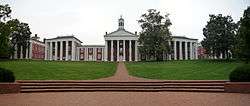Lee Chapel
|
Lee Chapel, Washington and Lee University | |
|
Lee Chapel | |
  | |
| Location | Washington and Lee University campus, Lexington, Virginia |
|---|---|
| Coordinates | 37°47′14″N 79°26′32″W / 37.78722°N 79.44222°WCoordinates: 37°47′14″N 79°26′32″W / 37.78722°N 79.44222°W |
| Built | 1867 |
| Architectural style | Late Victorian |
| Part of | Washington and Lee University Historic District (#71001047) |
| NRHP Reference # | 66000914 |
| VLR # | 117-0019 |
| Significant dates | |
| Added to NRHP | October 15, 1966[1] |
| Designated NHL | December 19, 1960[2] |
| Designated NHLDCP | November 11, 1971 |
| Designated VLR | September 9, 1969[3] |
Lee Chapel is a National Historic Landmark in Lexington, Virginia, on the campus of Washington and Lee University. It was constructed during 1867–68 at the request of Robert E. Lee, who was President of the University (then known as Washington College) at the time, and after whom the building is named. The Victorian brick architectural design was probably the work of his son, George Washington Custis Lee, with details contributed by Col. Thomas Williamson, an architect and professor of engineering at the neighboring Virginia Military Institute. General Lee, along with much of the rest of the Lexington community, attended church services at Grace Episcopal Church, a hundred yards south, at the edge of the college campus. (That church was later renamed R. E. Lee Memorial Episcopal Church.)
When Lee died in 1870, he was buried beneath the chapel. His body remains there to this day, and for this reason among others, the Chapel is one of Lexington's major historical tourist attractions.

A centerpiece on the stage of the chapel—where the pulpit would be in a less secular place of worship—is a statue of Lee, in his uniform, asleep on the battlefield (the "Recumbent Lee"), designed by Edward Valentine. On the walls are two paintings: one of General Washington himself, by Charles Willson Peale, from the Washington family collections, and the other of Lee in his uniform, painted by Edward Pine. There is also a plaque given by the Sigma Society on one of the walls that honors two Sigma alumni from the classes of 1912 and 1915 who lost their lives in World War I.
In the basement a crypt (added after Lee's burial) contains much of Lee's direct family: the General himself, his wife Mary, his seven children, and his parents—Henry "Light Horse Harry" Lee, who had been a general during the Revolutionary War, and Anne Carter Lee. Lee's favorite horse, Traveller, is buried just outside the Chapel, where students of Washington and Lee traditionally leave coins or apples in hopes of being compensated with good fortune in their studies. In the basement of the Chapel is a museum that illuminates the history of the family of George Washington and Lee as well as that of the university itself. Lee's office has been meticulously preserved in almost exactly the same condition as it was when he died.
Further, the Chapel continues to play an important role in the modern operation of Washington and Lee. It seats about 600 in its main area and a small, three-sided balcony. Freshmen are brought there to hear a lecture from the President of the University's student-run Executive Committee on the school's famous Honor System. Important school-wide lectures, concerts, and other notable activities are also held here from time to time. On August 6, 2014, the confederate flags in the chapel were removed after student protest.[4] It was then agreed that the chapel's original flags, which were retired in the 1990s due to deterioration,[4] were to be put on display on a rotating basis in the chapel's museum.[4]
Lee Chapel was designated a National Historic Landmark in 1963. It is open for tours based on the following schedule:
- Apr 1 - Oct 31: 9 a.m. to 5 p.m., Monday through Saturday, and 1 to 5 p.m. on Sundays
- Nov 1 - Mar 31: 9 a.m. to 4 p.m., Monday through Saturday, and 1 to 4 p.m. on Sundays
See also
- List of National Historic Landmarks in Virginia
- National Register of Historic Places listings in Lexington, Virginia
References
- ↑ National Park Service (2007-01-23). "National Register Information System". National Register of Historic Places. National Park Service.
- ↑ "Lee Chapel, Washington and Lee University". National Historic Landmark summary listing. National Park Service. Retrieved 2008-06-26.
- ↑ "Virginia Landmarks Register". Virginia Department of Historic Resources. Retrieved 19 March 2013.
- 1 2 3 http://www.wdbj7.com/news/local/wl-to-remove-confederate-flags-from-lee-chapel/26847628
External links
| Wikimedia Commons has media related to Lee Chapel. |
- Lee Chapel and Museum
- Lee Chapel in Encyclopedia Virginia
- Washington & Lee University, Lee Chapel, Lexington, Lexington, VA: 10 photos, 10 data pages, and 1 photo caption page at Historic American Buildings Survey




